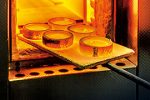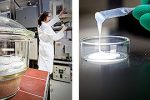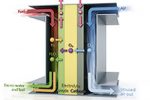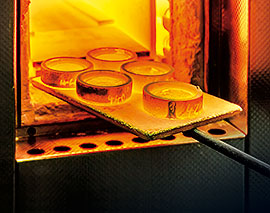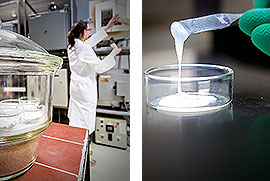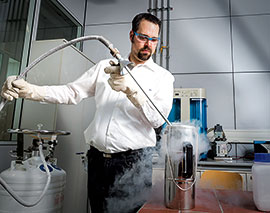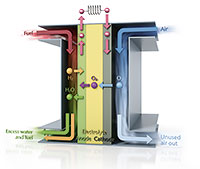Even as far back as 1870, the French science fiction author Jules Verne was convinced that, in his own words, ”water is the coal of the future.” But it was actually the German researcher Christian Friedrich Schönbein who found out in 1838 that electrical power can be generated very efficiently by way of the chemical reaction between hydrogen and oxygen. The reusable ”waste product” is what we call water. While the dynamo generator that relies on movement to generate electricity became popular more quickly, this technology, using the chemical reaction between hydrogen and oxygen, has experienced a renaissance ever since the first moon missions were successfully supplied with power by fuel cells in the 1960s. Many different versions were developed for mobile and stationary use. The high temperature fuel cell is believed to have particularly good market potential.
Electricity and heat for households
Hydrogen almost always comes in bound form here on Earth; however, the SOFC, due to its high operating temperature of between 600 and 1,000°C, is the only device capable of also using fossil fuels to supply hydrogen. This means the existing infrastructure can be put to flexible use with natural gas and biogas, as well as heating oil or diesel – a huge advantage in introducing energy-efficient technology.
This market is young and continues to grow. More than ten thousand heating fuel cells are currently in operation in Japan and about 600 in German homes. Their performance data has been continuously evaluated since 2008 by performing the field test ”Callux.” The third generation of these devices already brought an increase in the electrical efficiency from 30 to over 60 percent. The overall efficiency ranges between 90 and 98 percent. At the same time, the price per unit dropped by 60 percent and maintenance costs by 90 percent. ”The performance of today’s SOFCs is quite impressive. At the same time, however, the materials these cells are made of are subjected to severe stress due to the high temperature and humidity. The sealing technology is particularly important to maintaining the high efficiency of the fuel cell for years,” says Dr.-Ing. Mihails Kusnezoff, an expert on energy systems at the Fraunhofer Institute of Ceramic Technologies and Systems IKTS in Dresden.
In this case, special glass is the material of choice. A permanent hermetic bond forms between the oxide ceramic electrolyte and the metal of the cell housing when it is melted. This ensures that no uncontrolled exchange of gas takes place. Furthermore, the interconnectors of the cells that are switched in series as part of a ”stack” are isolated electrically even at high temperatures by alkali-free glass. SCHOTT is a global leader in developing and manufacturing sealing glass. This special glass is ground down into a powder and then applied using an organic binder. Out of the wide range of standard glasses and customer-specific solutions, the solder is matched exactly to suit the coefficient of thermal expansion of the metals and ceramics to be joined to ensure hermeticity without tension, even when temperatures shift.
”The high operating temperature of the SOFC poses a special challenge because many types of glass turn soft and elastic at temperatures of 500 °C and higher,” explains Dr. Jens Suffner, product developer at SCHOTT Electronic Packaging in Landshut, Germany. ”For this reason, we use specially matched glasses that have defined crystalline phases that expand as temperatures rise due to their higher coefficients of thermal expansion. This ensures that the mass remains gas-tight and remains in place like viscous honey,” he adds.
SCHOTT is one of the leaders in this area of research. In fact, SCHOTT was a partner in the project ”SOFC20” on successfully developing the system demonstrator for a ”hot box” with 5 kW of electrical output and over 50 percent electrical efficiency. Furthermore, in the EU project called ”Endurance,” improved materials and analysis and manufacturing techniques for the next generation of fuel cell stacks that have longer lifespans are being developed with international partners. The fuel cell is not only considered to be a significant contribution to the future energy supply in the EU, however. Research activity has also been picking up in Japan, the USA, South Korea and other countries in recent years. Considerably more money is being invested in energy efficiency because the world’s hunger for energy continues to grow – by about 40 percent by 2035, according to a BP estimate published in a recent study.
How a high temperature fuel cell works
Energy is released when hydrogen (H2) reacts with oxygen (O2). The ”cold combustion” must take place in a controlled manner in order for it to be utilized. With a Solid Oxide Fuel Cell (SOFC), an oxide ceramic electrolyte acts as a membrane and separates the gas next to the cathode (O2) from the gas next to the anode (H2 or methane CH4 from biogas, for example). It only permits the negatively loaded oxygen ions to pass through at a high temperature. They bond with the hydrogen ions on the anode side to form water and the carbon oxidizes to produce CO2. The electrons, on the other hand, are guided by an electrical load, which they then supply with electricity. 50 percent electrical efficiency was achieved in the SOFC20 project that SCHOTT was involved in. The waste heat from the high temperature fuel cell is used to generate heat.

